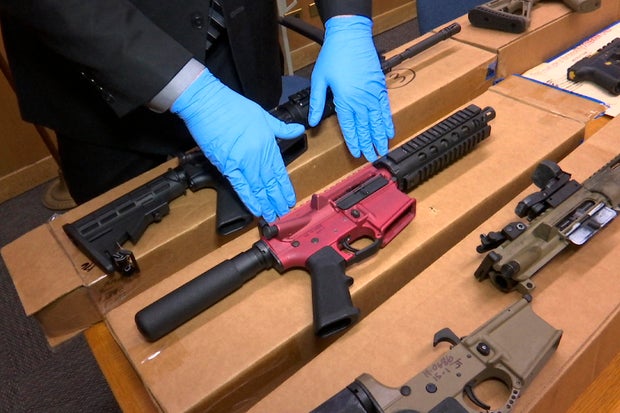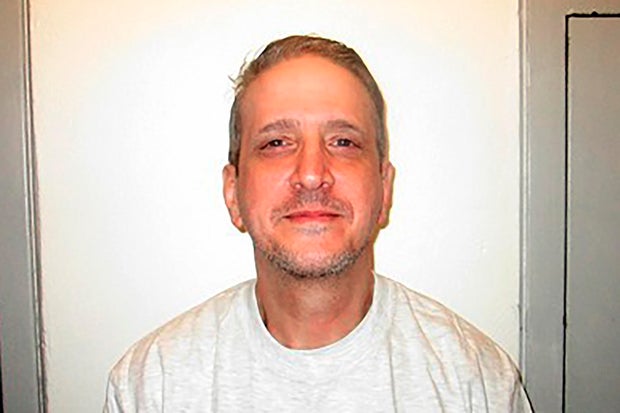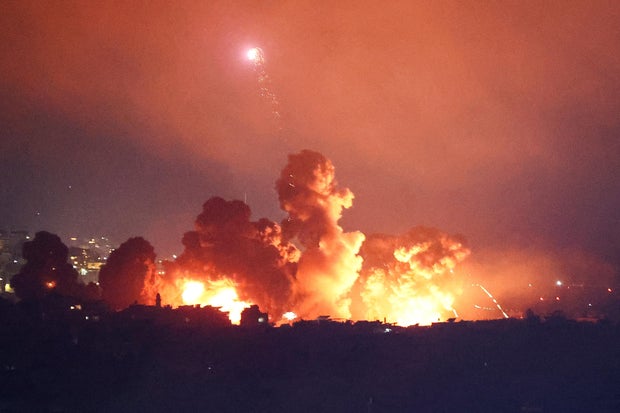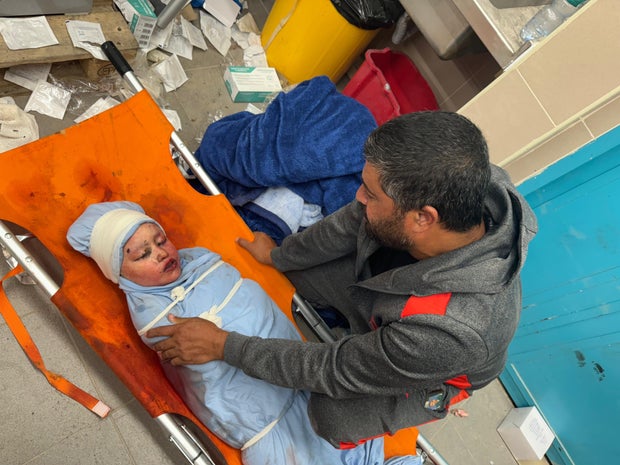CBS News
The Supreme Court’s new term starts next week. Here’s what to know and the cases to watch.

Washington — The Supreme Court will kick off its new term Monday, taking the bench for the first time since the justices handed down blockbuster decisions over the summer on guns, a widely used abortion pill, the regulatory power of federal agencies and presidential immunity.
The upcoming term, which will stretch into June 2025, is shaping up so far to be quieter than the Supreme Court’s last. But the justices are still poised to hear cases on hot-button issues like LGBTQ rights, an age-verification law for pornographic websites and the Biden administration’s efforts to combat gun violence.
And looming over the start of the new term is the November election, which could bring legal battles over the presidential contest before the high court. The justices have already been asked to intervene in disputes over Arizona’s proof-of-citizenship voting requirements and efforts by Green Party candidate Jill Stein and independent Robert F. Kennedy, Jr., to be restored to the ballots in Nevada and New York, respectively.
The court returns to the bench facing steady criticism for some of its most significant rulings, beginning with its June 2022 decision overturning Roe v. Wade and continuing with the July ruling granting former President Donald Trump some level of immunity from federal prosecution. Justices Clarence Thomas and Samuel Alito have also been under scrutiny from Congress over their adherence to ethics laws and practices.
Calls to reform the Supreme Court have followed criticism of the justices and their rulings. President Biden came out in favor of 18-year term limits and an enforceable code of ethics for the justices, as well as a constitutional amendment clarifying that former presidents are not immune from federal prosecution. Vice President Kamala Harris, the Democratic presidential nominee, backs the reforms and has urged Congress to act.
While the differences among the justices are typically revealed to the public through their written opinions and dissents, recent leaks to the media have provided a window into the court’s internal deliberations, and some of the justices have not shied away from voicing their frustrations.
In addition to the shocking and unprecedented leak of a draft Supreme Court opinion reversing Roe, the New York Times reported in September on internal memos and discussions surrounding three cases that involved Trump, including the immunity ruling that has sparked significant pushback against the high court.
Lisa Blatt, a lawyer who has argued 50 cases before the Supreme Court, said during a Federalist Society event that “something does feel broken,” and observed that some of the justices “feel visibly frustrated” during oral arguments.
Here are four cases to watch in the Supreme Court’s new term:
New rules for ghost guns
Haven Daley / AP
On the second day of the term, Oct. 8, the Supreme Court will hear arguments in Garland v. VanDerStok, a challenge to a regulation from the Bureau of Alcohol, Tobacco, Firearms and Explosives that imposed requirements on the makers and sellers of untraceable firearms known as ghost guns. The case doesn’t involve the Second Amendment, but instead revolves around whether the ATF went too far when it issued its measure regulating the weapons.
Ghost guns are unserialized firearms that can be assembled from kits sold online, and there has been a surge in the number of these firearms recovered by law enforcement each year, according to the Biden administration.
Implemented by the ATF in April 2022, the rule amended the definition of “firearm” under the 1968 Gun Control Act to include certain weapon parts kits. It also clarified that partially complete frames and receivers that can be converted into functional firearms qualify as regulated weapons.
The measure subjects covered manufacturers and sellers to the same rules that apply to commercial gun sales and requires them to obtain licenses, mark their products with serial numbers, run background checks and keep purchase records. It applies to all untraceable firearms, including those made with 3D printers or sold as assembly kits.
Shortly after the rule took effect, a group of gun owners, advocacy groups and ghost gun distributors sued the ATF, arguing it overstepped its authority. The challengers prevailed before a district judge and the U.S. Court of Appeals for the 5th Circuit, which invalidated the portion of the rule defining “frame or receiver” and found the 1968 Gun Control Act’s definition of “firearm” doesn’t include weapon parts kits.
The Biden administration appealed the decision to the Supreme Court and is urging the justices to reverse the 5th Circuit.
The justices have already intervened in the case on an emergency basis. In a divided 5-4 decision, the high court paused the district court’s decision invalidating the rule, allowing it to take effect while litigation played out. Roberts and Justice Amy Coney Barrett joined with the three liberal justices in allowing the Justice Department to enforce the measure.
That order will remain in place until the Supreme Court issues a decision in the case, expected by the end of June 2025.
An Oklahoma death row inmate’s bid for a new trial
Oklahoma Department of Corrections via AP
Death row inmate Richard Glossip’s bid for a new trial will be before the justices on Oct. 9. The case is known as Glossip v. Oklahoma, and it’s unique in the fact that the state’s Republican attorney general has argued that Glossip’s murder conviction and death sentence shouldn’t stand because of issues with his trial.
Nine execution dates have been set for Glossip and he has had his “last meal” three times, according to the Death Penalty Information Center. His most recent execution date was in May 2023, but the Supreme Court blocked it after the attorney general, Gentner Drummond, said he didn’t receive a fair trial.
Glossip was convicted in the 1997 killing of Barry Van Treese, the owner of the motel where he worked. He was found guilty in two different trials, though his first conviction was reversed due to ineffective assistance of counsel. In both instances, the prosecution relied on the testimony of Glossip’s co-defendant, Justin Sneed, who admitted to robbing and killing Van Treese but said Glossip hired him to carry out the murder.
Sneed was sentenced to life in prison.
An independent counsel investigated Glossip’s case and raised issues with Sneed’s credibility as a witness. Evidence previously withheld by the state and made available to the defense in January showed that Sneed was evaluated by a jail psychiatrist and diagnosed with bipolar affective disorder in 1997, after the murder and while he was in jail. Sneed was prescribed lithium by the psychiatrist. Interview notes from 2003, which Drummond said were not turned over by the state, indicated the prosecutor knew about Sneed’s treatment.
The attorney general said Sneed testified during Glossip’s second trial in 2004 that he had never seen a psychiatrist. That information, as well as that he received lithium for a psychiatric condition, may have impacted how the jury viewed Sneed as a witness, according to the attorney general.
Drummond told the Oklahoma Pardon and Parole Board in April that he supported clemency for Glossip, citing the independent reviews of the case that suggested he receive a new trial. But the parole board voted not to recommend clemency. The attorney general also asked the Oklahoma Court of Criminal Appeals to wipe away Glossip’s conviction, though it, too, rejected the request.
This is not the first time Glossip has been before the Supreme Court. In 2015, he unsuccessfully challenged Oklahoma’s lethal injection protocol. Justice Neil Gorsuch is sitting out of the court’s consideration of the case, likely because of his prior stint as a judge on the U.S. Court of Appeals for the 10th Circuit, which covers Oklahoma.
Tennessee’s ban on sex-transition treatments
The most closely watched case of the term, U.S. v. Skrmetti, involves a Tennessee law that bans certain sex-transition treatments for minors experiencing gender dysphoria. A decision could have wide-ranging impacts — more than 20 states have enacted laws in recent years limiting access to treatments like puberty-blocking drugs, hormone therapy or surgeries.
Tennessee’s law, SB1, was enacted in March and bars health care providers from prescribing, administering or dispensing any puberty blocker or hormone if the treatment is meant to “enable a minor to identify with, or live as, a purported identity inconsistent with the minor’s sex” or treat “purported discomfort or distress from a discordance between the minor’s sex and asserted identity.”
Puberty-blockers or hormones can also be used to treat conditions like precocious puberty, disease, a congenital defect or physical injuries.
The law took effect in July 2023, but it allowed covered treatments that began before then to continue until March 31.
Two transgender boys and one transgender girl, all of whom were diagnosed with gender dysphoria and received gender-affirming care, challenged the ban, arguing it violates the 14th Amendment’s promise of equal protection of the laws. The Justice Department also intervened.
A federal district court blocked the law, finding it was likely unconstitutional, but a divided panel of judges on the U.S. Court of Appeals for the 6th Circuit reversed the decision.
The Justice Department and transgender teenagers then appealed to the Supreme Court, and the justices agreed to hear the Biden administration’s challenge. But if Trump defeats Harris in November, the Justice Department will likely change its position in the case once he takes office. Arguments have not yet been scheduled.
The dispute thrusts the justices into the culture wars, as Republican-led states have in recent months taken steps that critics argue are restricting transgender rights. In addition to the laws barring treatments for minors experiencing gender dysphoria, states have prohibited transgender girls from playing on female sports teams. Some red states have also challenged the Biden administration’s new rules protecting transgender students from discrimination under Title IX.
Chase Strangio, co-director of the ACLU’s LGBTQ and HIV Project, told reporters during a preview of the Supreme Court’s term that the challenge to Tennessee’s law has a “huge impact” on the future of litigation on behalf of LGBTQ individuals.
“The resolution of this case is critical for access to this health care across the country,” he said, calling the legal battle an “inflection moment” of whether the court will clarify that transgender people are covered by the Constitution and civil rights laws.
Age-verification for pornographic websites
Although no date has been set for arguments, the case known as Free Speech Coalition v. Paxton involves a Texas law that requires pornographic websites to verify the ages of their visitors.
The dispute began with the enactment of Texas House Bill 1181 in June 2023, which seeks to prevent minors from accessing sexual content online. The law requires any website where one-third of their content is harmful to minors to verify that every user attempting to access that content is at least 18 years old.
Websites covered by the law must also display health warnings about the alleged psychological risks of pornograpy. Social media platforms and search engines are not covered by the age-verification law. Violators may face civil penalties of up to $10,000 per day, and if a minor accesses sexual material, the state can seek an additional $250,000 per violation.
Texas is not the only state with such a law in effect — Arkansas, Louisiana, Mississippi, Montana, North Carolina, Utah and Virginia all require covered websites to verify the ages of their visitors.
The Free Speech Coalition, a trade group for the adult entertainment industry, as well as a group of companies that operate pornography websites, challenged the Texas law, arguing it violates the First Amendment.
The challengers prevailed before a federal district court, which blocked enforcement one day before the measure was set to take effect. The U.S. Court of Appeals for the 5th Circuit then upheld the law, finding that the age-verification requirement doesn’t violate the First Amendment.
“The central issue in Free Speech Coalition v. Paxton is whether adults’ access to speech that is fully protected but disfavored by the government can be burdened in the name of protecting kids,” said Vera Eidelman, a staff attorney with the ACLU, which is representing the Free Speech Coalition. “Another way to think about it is whether adults in America will continue to have the right to freely access sexual content online.”
One issue in the dispute is the level of scrutiny the district court applied when evaluating the constitutionality of the law. The court of appeals said the proper standard was rational-basis review, the minimum level of scrutiny, and found the age-verification requirement is “rationally related to the government’s legitimate interest in preventing minors’ access to pornography.”
But the Free Speech Coalition argues it should be subject to strict scrutiny, the highest standard of review that courts use.
The Supreme Court has already declined a request for emergency relief, which would’ve blocked Texas from enforcing the law during legal proceedings.
CBS News
12 bodies bearing signs of torture found with cartel messages in Mexico, authorities say

Twelve bodies were found on Thursday in the central Mexican state of Guanajuato, local authorities said, attributing the killings to disputes between organized crime groups.
Guanajuato, a thriving industrial center that is also home to popular tourist destinations, is currently Mexico’s most violent state, according to official homicide statistics.
The 12 bodies were found within two hours in five locations in the city of Salamanca, according to the state prosecutor’s office, which is investigating the crime.
The victims — three women and nine men — were found on roads, bridges and avenues, their bodies bearing gunshot wounds and signs of torture, while one was dismembered, officials said.
The state prosecutor’s office also said the perpetrators left messages in which a cartel claimed responsibility.
Messages are often left on victims’ bodies by drug cartels seeking to threaten their rivals or punish behavior they claim violates their rules.
The bodies were found less than 24 hours after gunmen attacked a residential center for people suffering from addictions in the same municipality, killing four.
MARIO ARMAS/AFP via Getty Images
“This month of October has started with very high crime rates here. That makes 16 people (murdered) so far,” Salamanca Mayor Cesar Prieto told reporters.
But he said the violence affecting the city was “a temporary issue” that flares up “when one group decides to attack another.”
In Guanajuato, two cartels, the Santa Rosa de Lima and the powerful Jalisco New Generation, are currently at war.
Police, politicians and civilians have all been targeted in Guanajuato. In June, a baby and a toddler were among six members of the same family murdered in Guanajuato. In April, a mayoral candidate was shot dead in the street in Guanajuato just as she began campaigning.
Last December, 11 people were killed and another dozen were wounded in an attack on a pre-Christmas party in the state. Just days before that, the bodies of five university students were found stuffed in a vehicle on a dirt road Guanajuato.
The U.S. State Department urges American to reconsider traveling to Guanajuato. “Of particular concern is the high number of murders in the southern region of the state associated with cartel-related violence,” the department says in a travel advisory.
Hit by spiraling violence linked to organized crime, Mexico has recorded more than 450,000 murders since December 2006, when a controversial military anti-drug operation was launched.
New President Claudia Sheinbaum announced that she will present her national security plan next Tuesday.
CBS News
Israel says attack hits Iran-backed Hezbollah’s intel unit as Lebanon puts two-week death toll over 2,000

A fierce round of new Israeli airstrikes pummeled buildings in the southern suburbs of Lebanon’s capital overnight, with Israel’s military saying Friday that it had targeted another headquarters of the Iran-backed group Hezbollah. The strike came hours before Iran said its foreign minister had arrived in Beirut — the first visit by a senior Iranian official to Lebanon since the killing of Hassan Nasrallah, the Hezbollah’s longtime leader, and Iran’s Oct. 1 missile attack, for which Israel has vowed to retaliate.
Lebanese media suggested the target could have been a senior Hezbollah figure considered a potential successor to Nasrallah, who was assassinated in a similar Israeli strike in Beirut exactly one week ago.
NOTE: This article includes an image of a dead child that may disturb some readers.
The Reuters news agency cited Lebanon’s health ministry as saying Friday morning that at least 37 people had been killed and 151 others wounded by Israeli strikes in the country over the preceding 24 hours.
Ahmad Al-Kerdi/REUTERS
Five days of Israeli ground operations in southern Lebanon, near Israel’s northern border, and two weeks of airstrikes in that region and in southern Beirut — both Hezbollah strongholds — had killed more than 2,000 people, the health ministry said. More than 1 million people have been driven from their homes, including tens of thousands under Israel evacuation orders in almost 100 towns and villages near the border.
The blasts in Beirut’s southern suburbs overnight sent huge fireballs and plumes of smoke rising over the city. Lebanon’s state news agency said at least 10 consecutive strikes hit buildings in the southern suburb of Dahiyeh.
The Israel Defense Forces said it had targeted the “Hezbollah central intelligence headquarters,” but the country’s Army Radio network said the IDF was still working to determine whether any senior members of the group had been killed in the strikes.
Israel stepped up its assault on Hezbollah — long designated a terrorist organization by the U.S., Israel and many other nations — two weeks ago, vowing to push the well-entrenched group’s fighters and weapons back far enough from the border to stop a near-daily hail of rockets and drones targeting Israel.
Hezbollah started launching those attacks in support of its ideological ally Hamas, which is also backed by Iran, the day after Hamas sparked the ongoing war in Gaza with its Oct. 7, 2023 terrorist attack on Israel. The IDF says Hezbollah militants have fired over 10,000 rockets across the border since Oct. 8, 2023. The vast majority of them have been intercepted by Israel’s advanced missile defense systems.
Amr Abdallah Dalsh/REUTERS
Among those killed in Lebanon this week was U.S. national Kamal Ahmed Jawad, from Dearborn, Michigan. His family has said he was a volunteer who was killed in an airstrike in southern Lebanon.
The White House said in a statement that it was “deeply saddened” by Jawad’s death.
The U.S. government has warned Americans not to travel to Lebanon since mid-September, and urged any citizens in the country to leave via commercial travel routes. The government has been helping to organize seats on flights out of Lebanon for American citizens, State Department spokesperson Matthew Miller said earlier this week, as other nations book charter flights and make plans for potential evacuations.
Another Israeli airstrike cut off a main highway connecting Lebanon and neighboring Syria, Lebanese state media said Friday. Tens of thousands of people fleeing the fighting have crossed into Syria since Israel started expanding its military operations in Lebanon.
An Israeli military spokesperson said earlier that Hezbollah had been trying to move military equipment across the border into Lebanon via the highway that was reportedly struck on Friday. Hezbollah is believed to have obtained many of its weapons from Iran via Syria, according to The Associated Press.
Getty/iStockphoto
Lebanese officials have said most of the roughly half dozen crossings between Lebanon and Syria remain open.
The skyrocketing casualties are pushing Lebanon’s already-frail health care system to the brink. At least 40 paramedics and firefighters have been killed in the Israeli strikes over the past three days alone, according to Lebanon’s health minister. That includes about half a dozen medics killed in a strike late Wednesday night that hit a central Beirut office of the Health Society, a group of civilian first responders affiliated with Hezbollah.
The rapidly escalating violence in Lebanon comes weeks after Israel announced a deliberate shift of its military focus to that northern front, but the IDF has continued its operations in the Palestinian territories, too.
An IDF airstrike overnight in Tulkarem, in the northern part of the Israeli-occupied West Bank, killed 18 people, according to Palestinian officials. Israel has carried out a number of significant raids in the West Bank, including in Tulkarem, over the last year, usually saying the targets are Hamas fighters or commanders.
Stringer/Anadolu/Getty
The United Nations Office for the Coordination of Humanitarian Affairs (OCHA) said at least 678 Palestinians were killed by Israeli military operations in the West Bank between Oct. 7, 2023 and the end of September 2024, while 12 others were killed by Israeli settlers.
President Biden has backed Israel’s right to respond “in proportion” to Iran’s recent missile attack, but he’s also said more must be done to prevent the close ally’s fight with Iran’s so-called proxy groups from spreading into a wider war in the Middle East. Despite repeated U.S. calls for cease-fires, however, neither Israel, nor Hezbollah or Hamas, have shown any inclination to back down yet.
CBS News
Barack Obama to hit campaign trail for Harris
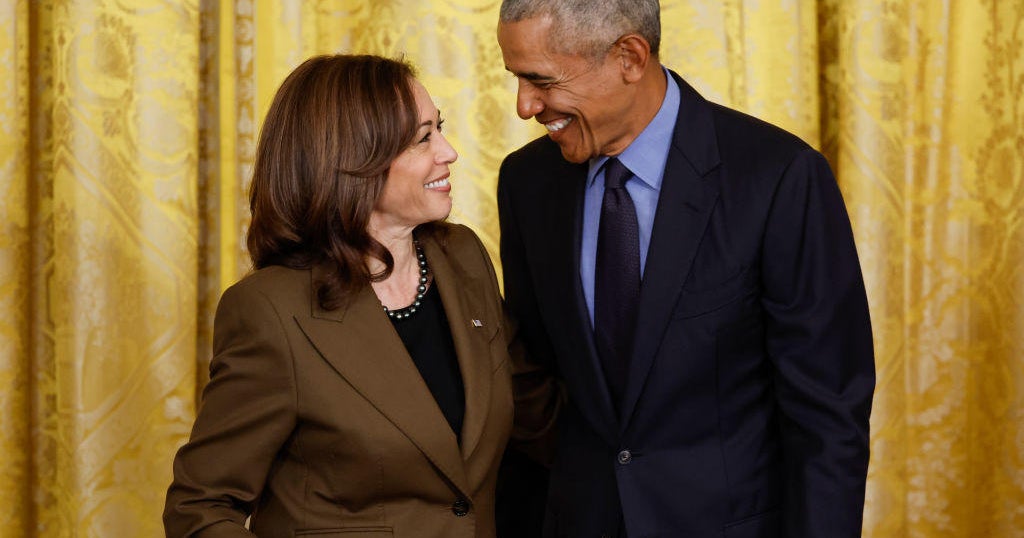
Former President Barack Obama will soon begin campaigning for Vice President Kamala Harris. He is set to embark on a blitz across the battleground states, with several events in the last month before Election Day.
The former president will kick off his campaign efforts next Thursday, Oct. 10, in the Pittsburgh area. It’s unclear if Harris will appear with him.
Obama has been a staunch supporter of Harris since she joined the top of the Democratic ticket, officially endorsing her just days after President Biden exited the race. Obama vowed to do anything he could to help Harris defeat former President Donald Trump.
“Kamala Harris won’t be focused on her problems, she’ll be focused on yours,” Obama said in an address at the Democratic National Convention in Chicago in August. “A president, she won’t just cater to her own supporters and punish those who refuse to kiss the ring or bend the knee. She’ll work on behalf of every American. That’s who Kamala is.”
Harris and Obama have yet to appear together this cycle, and while it is not yet known if they will before Election Day, their relationship stems back to when the former president was seeking a Senate seat in Illinois. Harris also campaigned for Obama during his 2008 presidential run.
Obama’s first campaign event will take place in one of the most contested battleground states. In 2020, President Biden won the Keystone state by less than 81,000 votes, flipping a state that Trump won in 2020.
Harris herself has visited Pennsylvania more than 13 times in 2024, and seven times since launching her presidential bid. Surrogates like her husband, second gentleman Doug Emhoff, have also campaigned in Pennsylvania.
The latest CBS News polling shows the presidential race remains a tight contest, with Harris up four points nationally over Trump, 52% to 48% among likely voters, and with a slight edge of 51% to 49% in the battleground states.


